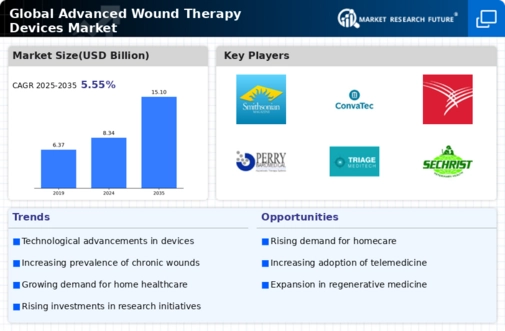Advanced Wound Therapy Devices Size
Advanced Wound Therapy Devices Market Growth Projections and Opportunities
The Advanced Wound Therapy Devices Market is significantly influenced by the aging global population. As the elderly population increases, so does the prevalence of chronic wounds, such as diabetic ulcers and pressure sores. Advanced wound therapy devices, including negative pressure wound therapy (NPWT) and electrical stimulation devices, are increasingly utilized for effective wound management in this demographic. Wound care is influenced by market dynamics which fluctuates with continuous innovations in technological manufacturing. States-of-the-art wound therapy devices are growing in multidirectional fold, being high on smart sensors, connectivity and performance of advanced materials to assure better outcome. Appearance of these innovations shapes a more competitive market structure where manufactures seek to provide the most advanced systems for wound control. The aspect of lack of obesity and diabetes in the market is a negative influence. People with diabetes have chronic wounds and consequently require advanced wound therapy for the treatment of such open wounds. Furthermore, comorbidities associated with obesity such as ulcers due to venous stasis contribute to the need for technology that enables proper and timely wound recovery and eliminates development risk factors. In turn, the number of surgical procedure has significantly affected market dynamics. Postoperative care of surgical wounds is described as specialized procedures, and such post-operation treatments cannot be absorbed without special units for wound therapy devices. With the surgical volume increasing, the need for products that promote the optimal healing process and prevent potential surgical site infections also grows. Irrelevantly the market is characterized by a trend in traumatic injuries, such as burns and accidents. To optimally heal due to traumatic wounds advanced wound therapy is in numerous cases necessary. There are various devices that help to propel a modern approach on managing complex wounds caused by trauma, such as hyperbaric oxygen therapy chambers and biosynthetic dressings. The specialty wound care clinics and centers play a crucial role as well, that is why such establishments are among the key factors for economic growth in Advanced Wound Therapy Devices Market. The main function of such facilities is to treat wounds through more holistic care, which is often carried out using advanced technologies and devices to increase the effectiveness of addressing these issues. This report, therefore, reflects on the continued spread of such facilities and how this leads to increased use of advanced wound therapy solutions. The economics of market dynamics and the cost-effective measures for containing health care costs are very important. Advanced wound therapy devices are often perceived as cost-effective solutions by reducing hospital stays, preventing complications, and improving overall patient outcomes. Healthcare systems increasingly recognize the value of investing in advanced wound care to minimize long-term costs.










Leave a Comment